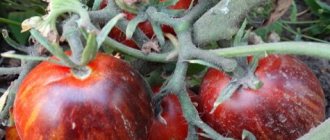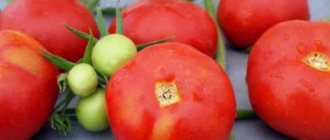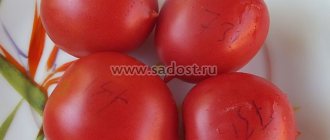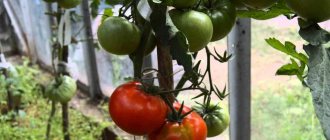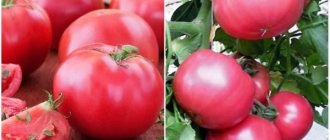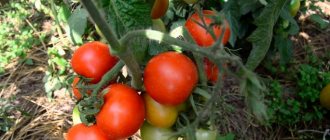Description of the variety
Fruit:
- Flattened-rounded in shape, with pronounced ribbing near the stalk;
- Those that have not reached varietal maturity are pale green in color. When ripe, it is deep pink in color;
- With a thin but dense skin that reliably protects the fruit from cracking;
- With fleshy, sugary, not watery, low-seeded pulp, pleasant, sweet taste;
- Large sizes. Average weight is from 350 to 400 grams. The first cluster often produces fruits weighing 600 grams or more.
Description of tomato:
Bushes:
- Indeterminate plant, moderately spreading, with average formation of green mass;
- It reaches a height of 1.8 to 2.0 meters;
- The leaves are large, simple, dark green in color.
Description and characteristics of the variety
Bogatyr is a determinate low variety. Designed for planting in open, film and glass beds. Low-growing bushes grow up to 0.6 m, which greatly simplifies care. The shoots are characterized by an average degree of foliage, but at the same time they are powerful and do not break under the weight of tomatoes.
Ripening is friendly with an average time of 110-115 days after germination.
The giant fruits reach 300-400 g, are fragrant, with excellent taste. Bright red color with a beautiful gloss. The pulp is fleshy, low in seeds, sugary and juicy at the break. The tough skin prevents cracking.
Tomato: advantages and disadvantages
The tomato variety “Russian Bogatyr” has the following positive qualities:
- Excellent taste characteristics;
- Good yield;
- Resistant to adverse weather conditions;
- Good keeping quality;
- Large fruit;
- Unpretentiousness in care;
- Possibility of transportation.
Gardeners include minor disadvantages of the variety:
- The need for formation;
- Increased demands on soil nutrition.
Growing tomatoes in a greenhouse
The time for planting sprouts in the ground is approximately in May (if the seeds were collected in March). It is preferable to plant the sprouts in a greenhouse, even if in the future you plan to transplant them into open ground. Young shoots are extremely sensitive to temperature changes.
For proper planting of tomatoes and further care for them, follow the instructions below.
Landing
The soil must be dug up and formed into beds. Each bed is moistened and mineral or organic (for example, humus) fertilizers are added to the soil. It is better to administer them in the form of an aqueous solution.
Carefully move each seedling from the container into the soil and sprinkle it on top with soil so that the roots of the plant are covered by 2 cm on top. Place the seedlings approximately 25 cm apart. So 4-5 bushes fit in one square meter.
Important! Do not plant the sprouts close to each other, as the Russian Bogatyr tomato has a spreading bush.
After planting, lightly water the beds again and leave them in the greenhouse. In the future, the sprouts will require regular watering, and they need to be fertilized 1-2 times a month.
Care
Caring for tomato bushes includes tying, pinching, watering, weeding, loosening and fertilizing the soil:
- Tying. Russian Bogatyr tomatoes grow large, both in the size of the fruit and in the size of the bush itself, so tying is necessary. This procedure is necessary so that, under the weight of large fruits, the branches of the plant do not break off and sink to the soil, as this will damage the fruits. There are 2 types of tying: vertical and horizontal. In the vertical type, the plant is tied to a vertical support (a peg or stick previously driven into the ground). Each branch is attached to a support and left fixed. When tying horizontally, plant branches are attached to a horizontal support (trellis). As a rule, a rope or wire stretched along the greenhouse closer to the top is chosen as such a support. Ropes supporting branches with fruits are tied to this support in the same way. For this variety of tomatoes, it does not matter which garter you choose: horizontal or vertical.
- Watering. The Russian Bogatyr tomato variety is unpretentious in watering, even in arid regions. If you forgot to water the garden bed, no problem: Russian Bogatyr does well without moisture for up to 2 weeks. However, it is better to water the tomatoes 2-3 times a week. When watering, make sure that drops of water do not fall on the leaves of the plants, so keep the watering can close to the ground. With abundant moisture, a fungal infection or burns caused by exposure to sunlight appears on the leaves.
- Weeding. Russian Bogatyr is not particularly picky about weeding, but do not forget that large weeds take nutrients from the plant, so they should be removed in a timely manner. As for small weeds, remove them as they grow.
- Loosening the soil. This is done so that the soil does not harden and allows the bush to grow freely, as well as to saturate the plant roots with oxygen. Weed the bed as the weeds grow, but be sure to loosen it after each watering. Loosening is done using a hoe or a special garden spatula.
- Fertilizing the soil. Fertilize tomatoes 1-2 times a month. Both mineral and organic fertilizers are used. Fertilizers promote the growth of healthy bushes and a bountiful harvest. Add fertilizers either to the soil itself when loosening, or to the water for irrigation.
- Stepsonning. Not many novice gardeners know about pinching, but in vain: in our case, this is a mandatory procedure for caring for tomato bushes. When pinching, young shoots and non-fruit-bearing branches that grow strongly are removed. Such shoots take away nutrients, which slows down the growth and development of fruiting branches. The treated bushes, which look like a stem and several fruit-bearing branches, produce a bountiful harvest. This procedure greatly simplifies the growth of the plant and its fruits and has a positive effect on the taste and quantity of fruits.
Diseases and pests
An integral part of plant care is pest and disease control. The Russian Bogatyr variety makes life much easier for summer residents, as it is immune to many diseases and is rarely attacked by pests. However, in any case, a good gardener should know the most common tomato diseases and pests, and practice ways to combat them.
The most common disease of tomatoes is late blight . This is a disease of fungal origin, which manifests itself in various spots on the leaves. This disease occurs if you water the bush too often and too much or if water gets on the leaves. Therefore, to prevent disease, it is necessary to follow the watering regime and not flood the beds. If the disease has already appeared, then the best control is to collect the affected leaves so that the disease does not spread from one leaf to another.
Important! Diseased leaves or plants are burned after removal.
After collecting the affected leaves, treat the plants with a copper-containing solution.
This is a preventative measure that helps prevent the infection from spreading further and kills it. Another disease is mosaic. It is also characterized by the appearance of white-yellow spots on the leaves and stem of the plant. However, infection occurs not through water, but through insects. The most common distributor of mosaic is aphid. Diseased areas dry out and fall off over time.
As a preventive measure and treatment for mosaic, spray the bushes with copper-containing preparations and a soap solution (4 tablespoons of liquid soap per 1 liter of water). The affected areas also need to be torn off and burned without waiting for them to spontaneously fall off.
It is worth remembering about a variety of insect pests and disease carriers. In addition to aphids, which spread the infection, these are Colorado potato beetles, whiteflies and mole crickets. All these insects harm plants in their own way. The whitefly eats the foliage along with the nutrients necessary for fruit growth. The cockchafer lays larvae in the soil, which eat the roots of the plant, causing it to subsequently die. The same damage is caused by the mole cricket and the Colorado potato beetle.
If pests are detected, it is necessary to treat the bushes and soil with a soap solution or special insecticide preparations that are sold in gardening stores.
If you follow all of the above instructions, namely stabilize the regime of watering, weeding, loosening, tying up bushes, feeding, pinching and preventing and treating diseases, destroying pests, by mid-summer you are guaranteed to receive a bountiful harvest of ripe Russian Bogatyr tomatoes.
Growing tomatoes
To speed up the growing process and guarantee good germination, the “Russian Bogatyr” variety is grown in seedlings.
How to prepare seeds?
Preparation of seed material:
- Pre-sowing seed disinfection is carried out in a weak solution of potassium permanganate. To do this, the seeds are soaked in the solution for 15-20 minutes. Afterwards, rinse thoroughly in clean water;
- Then the planting material is treated in a growth stimulator;
- It is best to germinate the seeds. They are placed on a damp cloth and left for 3-5 days. During this period, it is necessary to prevent the planting material from drying out.
Sowing seed material
How to sow seeds for seedlings:
- Sowing begins in early March;
- It is optimal to use light soil, which includes garden or turf soil and humus. The soil mixture for disinfection is calcined in the oven;
- The seeds are sown to a depth of 1.5 to 2 cm. The top is covered with a layer of peat and lightly compacted. Plantings are watered abundantly with warm water using a spray bottle. To speed up the germination process, containers with plantings are covered with transparent film and left in a warm room;
- As soon as the sprouts sprout, the containers are exposed to bright light. If necessary, fluorescent lamps are used as additional lighting. Reduce the temperature in the room to +15 degrees for 5-7 days. Afterwards, raise the temperature to +25 degrees;
- Throughout the entire growth period, seedlings are regularly watered, preventing the surface layer of soil from drying out;
- In the phase of two true leaves, seedlings are planted in separate pots and also fertilized with diluted complex fertilizer;
- 7 days before planting in a permanent place, they begin to harden the seedlings.
Rules for planting seedlings
How to plant tomato seedlings correctly:
- Seedlings are transplanted at the age of 60-65 days, with the indispensable presence of at least 7 leaves and one flower cluster;
- The bed is prepared in the fall. The soil is carefully dug up and compost, humus and wood ash are added;
- In the spring, the soil is loosened, superphosphate or wood ash (no more than 1 tbsp) is added to the planting holes;
- When planting, it is recommended to avoid crowding, placing no more than 3 seedlings per 1 m2;
- Sprinkle the top with soil and lightly compact it. The planted seedlings are watered;
- Immediately after planting, tomato bushes are attached to supports, preferably to trellises.
Characteristics of tomato Swat f1 and description of growing variety
Tomato Swat f1, the description of which indicates the universal purpose of the fruit, is one of the best tomatoes. During the growing season, a powerful bush is formed, on which large fruits of an even round shape ripen. The variety is resistant to stressful cultivation conditions.
Benefits of tomato
Swat tomatoes are first generation hybrids and are suitable for growing in any conditions. The seeds belong to class 1, which indicates a high germination rate. The description of the variety indicates an early ripening period.
Bushes of indeterminate type. In open ground, the height of the plant reaches 70 cm; when cultivated in a greenhouse, a bush 120 cm high is formed.
The characteristics and description of the variety are related to the parameters of the fruit. At the stage of technical ripeness, tomatoes acquire a pink color. Tomatoes have a smooth surface, juicy pulp, and large size. The weight of the fruit is 500 g. Sometimes the weight of tomatoes can reach 800 g.
Swat f1 tomatoes have a balanced taste. The fruits are intended for canning and fresh consumption.
Growing seedlings
When planting a crop, it is important to follow hygiene rules, as there is a possibility of infection reaching the seeds through the growing container. It is preferable to carry out all work when planting seeds with gloves, wash your hands periodically
For this purpose, you can use expanded clay or crushed charcoal. For planting, take a specially prepared soil mixture. You can simplify the process using a substrate, which is sold in stores.
The soil is lightly compacted, watered with warm water, holes are made 1 cm deep. The seeds are laid out at a distance of 3 cm from each other. The sowing is covered with a layer of dry soil, and the container is placed in a warm place.
To ensure the smooth emergence of seedlings, it is important to maintain the optimal air temperature at +28...+30 °C. Compliance with the temperature regime is required to accelerate the emergence of sprouts
Otherwise, the seeds will rot or the germination period will increase.
After the first shoots appear, lower the air temperature to +15...+18 °C during the day and +10...+12 °C at night. After 7 days, the air temperature is increased to +20...+25 °C during the day and +12...+15 °C at night.
Rules for cultivating the variety
Caring for tomato plants requires compliance with the rules of agricultural technology. Tomatoes need fertilizing with mineral fertilizers. Complex preparations are applied before planting seedlings in the ground.
At the cotyledon stage, plants are planted in separate pots. At the same time, the central root is shortened, resulting in a more developed root system. When picking, you need to monitor the condition of the root and prevent it from deforming.
After the appearance of 1 flower cluster, the formed seedlings are transferred to a permanent place when the air warms up to +13…+14 °C.
Plants are planted taking into account crop rotation. The best precursors for tomatoes are cucumbers, grains and legumes.
After planting in the ground, the seedlings are tied to a support after 10 days. In order to increase the yield, 1 stem is formed from the bush, and excess shoots are removed. As the tomatoes ripen, it is recommended to tear off the lower and partially middle leaves.
To increase productivity, it is recommended to fertilize with an aqueous solution of yeast. For preventive purposes against fungal diseases, the bushes are treated 2-3 times during the season with a mixture containing copper. It is recommended to use a Bordeaux mixture consisting of slaked lime and copper sulfate.
Bush care
How to care for tomato plantings:
- Water regularly and moderately, avoiding excessive soil moisture;
Watering is carried out with warm, settled water, only at the root, in the evening.
- The formation of a bush is carried out in one stem. After 3-4 brushes, the lateral processes must be removed. The possibility of pinching the growth point is allowed;
- Once every 14 days, tomato plantings are fed using complex mineral fertilizer, where phosphorus and potassium predominate;
- After each watering and rainfall, the soil is loosened. This will ensure a good supply of moisture to the root system, and will also saturate the soil with oxygen, which will have a beneficial effect on the development of the plant;
- When growing in greenhouse conditions, the greenhouse structure is ventilated every day. This will prevent the occurrence of fungal diseases;
- You can retain moisture in the soil and reduce the amount of loosening by mulching the soil. Straw, mowed grass, and peat are used as mulch.
Description of the tomato variety Vasily, its characteristics and cultivation
Healthy and tasty tomato fruits have long occupied pride of place on the beds and tables of Russians. Vasily f1 tomatoes appeared as a result of domestic selection. The originator was . Breeders have created a tomato that produces a harvest in the shortest possible time.
General information about the plant
Tomatoes of the Vasily variety are distinguished by early harvest. Early ripening made it possible to grow the plant not only in the south of Russia, but also in the central zone of the country. Characteristics of tomato and external description of the plant:
- Hybrid variety.
- Standard.
- Early ripening, the berries are ready for picking 80–85 days from planting.
- Low-growing, the height of the bushes does not exceed 0.6 meters.
- Determinant.
- Good yield.
- Average foliage of bushes.
- Strongly corrugated green foliage.
- Compact.
- Erect stem.
- Medium branched.
- Powerful root system.
- Resistant to weather changes.
- Inflorescences of intermediate type.
- Immunity to most nightshade diseases.
- Long fruiting period.
- Simultaneous harvesting.
- Easy to care for.
- Well preserved.
- It is possible to transport tomatoes without losing their presentation.
The popular Vasily tomato variety is grown by Ukrainian and Moldavian gardeners. Reviews confirm the high percentage of tomato yield. The plant should be cultivated based on the climatic characteristics of the region. Most vegetable growers recommend the greenhouse growing method. Planting tomatoes in open ground is permissible provided that the climatic conditions are suitable for heat-loving plants. Technical data and external features of the fruit:
- Round shape.
- Red color when mature.
- Green color during ripening.
- Small size.
- Average weight is 100 grams.
- Smooth.
- Not prone to cracking.
- Sweet taste, no sourness.
- Juicy, not watery.
- Lasting aroma.
Tomato fruits are suitable for whole-fruit canning and pickling. The universal nature of the berry allows it to be used not only as preparations, but also consumed fresh. The fruits are used as an ingredient for salads and for self-consumption. Its small size makes the variety suitable for decorations and festive table decorations.
Cultivation Tips
The originator recommends the variety for seedling planting. Healthy seedlings are obtained by following simple rules:
- Plant seeds to a depth of 1–2 centimeters.
- Pre-moistening of universal soil for planting nightshade crops.
- Temperature conditions from 21 degrees.
- Timely watering with water at room temperature.
- A lighting source that organizes a 16-hour sunny day.
IMPORTANT! Hardening off seedlings before planting in open ground ensures better tomato yields. The hybrid variety of Russian selection is not demanding in care
To obtain a decent harvest, it is necessary to follow simple rules of agricultural technology: watering, loosening the soil and removing weeds, feeding with complex mineral fertilizer
The hybrid variety of Russian selection is not demanding in care. To obtain a decent harvest, it is necessary to follow simple rules of agricultural technology: watering, loosening the soil and removing weeds, feeding with complex mineral fertilizer.
Diseases and pests
The tomato variety “Russian Bogatyr” has excellent resistance to diseases characteristic of tomatoes. But preventive measures will not be superfluous:
- The occurrence of crown or root rot can be prevented by moderate watering, as well as periodic loosening of the soil;
- When the first signs of late blight are detected, tomato bushes are treated with copper-containing preparations. Those parts of the plant that are affected are immediately destroyed;
- You can protect plantings from insect pests by periodically inspecting tomato bushes. Industrial insecticides are used to combat spider mites. Naked slugs are fought with an aqueous solution of ammonia. Washing the affected parts of the plant with warm soapy water is effective against aphids.
We grow seedlings
The process of growing seedlings has a standard technology. By following our instructions, you can easily germinate seeds and prepare seedlings for planting at home.
Seed preparation
Preparing seeds is a mandatory step when planting any plant.
First, purchased seeds must be disinfected. Place the seeds in warm water with a pinch of potassium permanganate and leave for half an hour. After this, start germination. Germination begins with laying out rows of seeds on a hard flat surface (tray, baking sheet, box or holes). Cover the top of the seeds with moistened gauze. Do not choose another fabric: gauze is best at feeding the seeds with moisture and allowing them access to air.
Important! The gauze must always remain damp for the seeds to germinate. When the gauze dries, moisten it with water from a spray bottle to avoid “flooding” the seeds.
To increase germination, growth stimulants are used - “Epin”, aloe juice with water.
Planting seeds
To plant seeds, you need to prepare a container, such as a box, and soil. Partially place the soil in a container, loosen it first, and water it a little. Then place the sprouted seeds in the soil in rows at a distance of 1.5 cm from each other and to a depth of about 2 cm. Then sprinkle a little earth on top and leave in a warm place for several days. Water the soil a little every day without letting it dry out.
Important! To create conditions close to greenhouse conditions, cover the box with transparent film. This will retain heat and contribute to the rapid formation of seedlings.
After germination, keep the box in a warm and constantly lit place. If there is not enough natural light, special fluorescent lamps create such conditions. These lamps are very helpful for gardeners, since when growing seedlings the light must be not only constant, but also comprehensive. Sunlight, as a rule, provides illumination only from one side of the box, which negatively affects seedlings.
It is also necessary to monitor the temperature in the room: it should be at least +20 degrees for healthy sprouts to appear. After 10 days, when the first shoots appear, bring this temperature closer to room temperature.
3-4 days after planting, the seeds should germinate, and after 2 weeks they should become seedlings. As soon as the first leaves appear on the seedlings, transplant them into separate containers (for example, plastic or clay cups) so that they do not interfere with each other. The main conditions for the full development of sprouts: regular watering, constant temperature. Then, after about a month and a half, your sprouts will be ready for planting in the ground.
Attention! To harden the plants and prepare them for transplanting into the greenhouse, periodically take the box outside or place it in an open window. Increase the time from a few minutes to 8-10 hours.
Reviews from gardeners
Galina Petrovna, 63 years old, Syzran
I love gardening and have been doing it for half my life. I especially like growing large-fruited tomatoes. "Bogatyr", for example. As a big family, we love tomato juice, especially homemade. I got used to making delicious juice and paste from these tomatoes. Well, of course, we also eat fresh tomatoes in the form of vegetable salads.
Read also: Vaccination of adeniums at home
As a beginner gardener, I do not have enough experience in growing vegetables. But the Bogatyr tomato has taken root with me. He loves warmth and sun, and we have enough of that. And what delicious tomatoes I pick. The main thing is that they can be used to make salads, winter preparations, and various sauces. And he is unpretentious in care.
Viktor Sergeevich, 54 years old, Sevastopol
I usually plant tall tomatoes, and then “Bogatyr” caught my eye. Well, I decided to try it. Very pleased with the first harvest. The neighbors keep asking what kind of interesting variety this is: the bushes are small, but the tomatoes are large. So I gave them some seeds, let them try it. In the meantime, I’m making tomato paste from tomatoes, which I love so much.
Russian Bogatyr is an incredibly tasty and healthy variety of tomatoes that is so difficult to find on store shelves. People fall in love with him after the first harvest. Novice gardeners like it for its ease of care and cultivation.
The plants present gardeners with large, fleshy fruits. Many positive qualities in one variety - this is the Russian Bogatyr tomato. We will tell you in detail how even a novice summer resident can get his harvest of these tomatoes and describe the step-by-step growing process from seed preparation to harvesting.
Features of cultivation
To get a good harvest, it is necessary to provide optimal conditions for the growth of tomatoes. The Bogatyr variety is picky about soil composition. Light and highly fertile soil is ideal for it. It is best if tomatoes grow in place of cabbage, cucumbers, onions, legumes or carrots.
Seedlings that have reached the age of 55-70 days can be planted in open ground. In the non-chernozem zone, tomatoes are usually planted on June 5-10, when the threat of frost is minimal. In other regions, you can plant bushes in a greenhouse or greenhouse as early as mid-May.
As you know, low-growing tomatoes grow not only in height, but also in breadth. Therefore, they need to be planted at a distance of at least 40 cm from each other and 60-70 cm between rows. Further care comes down to periodic watering with warm water. During the entire period of growth and ripening of fruits in open ground, 2-3 feedings with special fertilizer “AELITA-VEGETABLE” are used. This is a complex of water-soluble beneficial microelements that provide vegetable crops with all the necessary nutrients.
There is no need to pin and tie up the Bogatyr tomato. The main thing is to create optimal conditions for normal fruiting.
